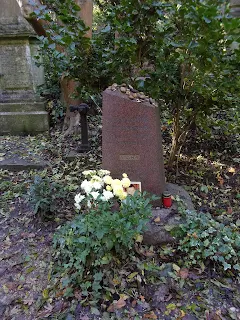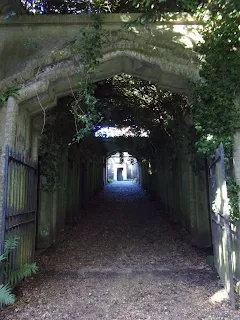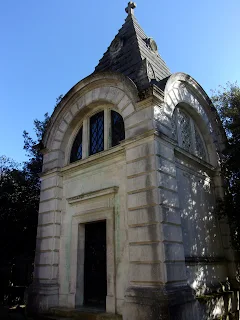My second visit to Highgate Cemetery was slightly different from my first, as last time the West Cemetery was only accessible via a guided tour. Following the pandemic, they've experimented with self-guided tours and it looks like they're staying. However, I'd recommend that anyone who hasn't been before does the guided tour, as our guide was very knowledgeable, took us to graves I might otherwise have walked straight past and told us many interesting snippets.
As a student (the first time) I worked as a cashier in six betting shops around Archway station and the Holloway Road, so am familiar with this area.
John Betjeman described the cemetery as a "Victorian Valhalla" and I would describe it as a stunningly evocative necropolis. I do find it a very peaceful place to be (at least the occupants aren't noisy😉) and it seems to have an almost magical, mystical, ethereal quality about it.
Here's the link to my previous blog, which was one of the first tourist attraction blogs I did, but I actually prefer my photos from that day. This time the sun was really bright for this time of year, and many of my piccies appear to be in full or partial silhouette.
And a clue as to a certain singer's whereabouts? Like the ending to Agatha Christie's long-running play, The Mousetrap, I'll keep it secret... But I'll maybe offer you up a riddle from the port side of the naked artist, and pass whilst seeking out other New Desperate Romantics...
The walk up Highgate Hill was a real fifteen to twenty minute killer for the legs (I've never been inside a gym and never will- I had enough trouble getting out of P.E. at school and anyway, the world is one giant gym!)
You have to cut through pretty Waterlow Park...
Duck pond, and weeping willows (my favourite tree.)💚
This is the triangular mausoleum of General Sir Loftus Otway (1775-1854) and his family, which has skylights on the top. Otway was a cavalry commander who served under Wellington in the Peninsular War
Does anyone know what the stacked stone effect represents? Is it representative of a cairn, which is a man-made stack of stones used to represent boundaries, landmarks, trails and burial sites? Is it a modern cairn which is a memorial?
I'd be grateful if someone could enlighten me.
The dark, pointed grave to the right is that of British actor Bob Hoskins (1942-2014). The grave is covered with (intentional) foliage, so I can't make out his name, but I knew what I was looking for! It's in a private area, and there were grave diggers around, so I couldn't get any closer.
Professor Man Fong Mei (1946-2014) was a pioneer of Chinese medicine. He lived in London and was passionate about East-West exchange, inventing the world's first disposable traditional acupuncture needle at a time when the practice of reusing acupuncture needles was creating controversy, due to the risks of cross contamination.
Beautiful actress and singer Jean Simmons (1929-2010) was British, started her career over here and then gravitated to Hollywood. She was known as one of J. Arthur Rank's "well-spoken young ladies."
I can't read the inscription on this, but took a photo because I liked the modern swirl design, which has an aura of peace about it.
George Michael's grave is on an intersection and is unmarked by a headstone and not marked on their map- but it's easy to find if you know what to look for and where to find it.
There is a sign saying that no photography is allowed, but naughty little me took a sneaky piccie whilst prying eyes (there were gardeners in one direction, and grave diggers to another) were otherwise occupied. Nature had the last laugh as I didn't have time to adjust my camera settings or take measures to counteract the bright sunlight, and this photograph is not the best.
The grave looks both simple and beautiful. The cross is engraved with George's mum's name; her daughter Melanie is to her right and George is to her left. Incidentally, both George (1963-2016) and Melanie died on Christmas Day.😢
Ironically, George's corner (I won't be cheesy and nickname it "A Different Corner"😉) was the one I passed the most, whilst looking for the graves of other famous people.
Jane Arden (1927-82) was an actress, film director, singer and songwriter, as well as a poet.
He was the grandson of Sigmund Freud, the founder of psychoanalysis, and whilst studying on my art foundation course I visited Whitechapel Art Gallery, where a display of his striking nudes was showing.
The Egyptian Avenue was created when the cemetery opened, due to a contemporary interest in Egyptology (owing to the fact that many objects had been taken from that country and rehoused in the British Museum.)
It's a gentle ascent up this passageway of solemn grandeur. It was once enclosed like a tunnel, but is now open to the sky. That eerie gloominess did not prove popular, and in Highgate Cemetery's 1965 guidebook it's referred to as a "cold stony death palace."
There are eight vaults on each side, and each vault can contain up to 12 coffins- but the Egyptian Avenue is not full to capacity; as happens when families move away or die out.

The avenue leads into the Circle of Lebanon...
The cemetery featured in the 2009 film Dorian Gray, and you can see Dorian walking around the circle...

Nature reclaiming back headstone space on the outskirts of the circle...
The Columbarium came into being after the cemetery gained a licence, in 1888, to inter cremated remains.
Columbaria are little compartments for the storage of cremated remains, and the word derived from the Latin for dovecotes, which is "columba."
I can just about make out the name Caitlin...
(Marguerite) Radclyffe Hall (1880-1943) was a poet and novelist. A lesbian during a a time when it was considered scandalous (this is a vanished world- nowadays two women can marry) she often went by the name "John" and dressed in trousers, as well as wearing monocles and hats, which were the fashion for gentlemen of the era.
Climbing the steps out, and the Circle of Lebanon once had a great cedar tree right in it's centre, but it had to be felled in 2019 as it was diseased. It predated the cemetery, was in the grounds of Ashurst House (sold in 1830 and demolished) and was thought to be over 100 years old when Stephen Geary (architect and founder of the London Cemetery Company) first drew up his design.
It may have been the idea of David Ramsay (the cemetery's landscape architect) to conserve the tree as a feature. It has been replaced by a new tree, but it will be years before this rather spindly thing will reach the magnificence of its predecessor!
The Terrace Catacombs were built in 1838-9 and are lit by oculi (circular windows). It consists of a long gallery (80 yards) with recesses, each large enough to take a single coffin end-on
You can only enter the Terrace Catacombs by means of the guided tour, so I have been inside before.
Imposing bird on one side of the Egyptian Avenue, with St. Michael's Church in the background.
Walking further round the upper circle, and the graves here seem almost regal, although to my knowledge no members of the royal family are interred in this cemetery.
Carl Rosa's (1842-89) tomb. This impresario was born in Germany and founded the popular Carl Rosa Opera Company. His second wife, Josephine and his daughter, Violet, are also buried here.
The Beer Mausoleum was erected by Julius Beer (1836-80) and was modelled on the Mausoleum of Halicarnassus, one of the Seven Wonders of the Ancient World.
Wealthy Beer, who'd made a fortune on the London Stock Exchange actually had this built for his younger daughter, Ada Sophia. She died five years before him at just eight-years-old.
They are in Kensal Green Cemetery, along with a "who's who" of Victorian society. Here is the link:-
http://elainerockett.blogspot.com/2018/11/miss-elaineous-visits-kensal-green.html
I'm not sure what the stone birds sitting atop the Egyptian Avenue exit are- doves are apparently found in graveyards a lot, as they represent peace, and are considered to be messengers of God, but these look more like eagles.
This horse grave is used as a guiding reference point on their map...
Michael Faraday (1791-1867) was a chemist and physicist, considered to be a great scientific discoverer; possibly of all time.
Safety warnings dictate that you're not to walk in this area, and I can see why!
Thomas Sayers (1826-65) was a hugely popular bare-knuckle fighter. His faithful dog "Lion" rode right behind his cortege, as chief mourner, after his master's early death due to ongoing bad health and excessive drinking.
I adore this grave (I would, I'm a Leo!) which is the memorial to successful travelling menagerie owner George Wombwell (1777-1850). By 1839 he had 50 wagons touring with his collection of giraffes, leopards, lions, elephants, monkeys and zebras.
This is a statue of "Nero," who would have nothing to do with the rather unsavoury entertainment of lion-baiting, preferring to lie around doing nothing. Good for him!💗
One of these is the grave of charismatic, Irish-born Presbyterian minister, Rev. Josias Wilson (1799-1847) but I'm damned if I know which- I couldn't even make out all the inscriptions as I stood there.
An artist, poet and artist's model, she was Rossetti's primary muse, although the most famous painting she posed for was John Everett Millais's 1851-52 painting Ophelia.
Christina Rossetti (1830-94) is also here. She is considered to be one of the Victorian era's finest poets and was Dante Gabriel Rossetti's sister.

This is known as the Goldhammer Sepulchre. It was commissioned by the wife of a late American businessman, completed in 2019, and is the only 21st century mausoleum.
Writer Douglas Adams (1952-2001) is best remembered for The Hitchhiker's Guide to the Galaxy. Fans leave pens on his grave, paying homage to his talents.
This is a not the best of photos- someone was standing right in front, and I had to kind of edge in from the side and zoom in from a distance. I do like the lumpen grave with its swirly writing next to him as well. Both graves are a good indication that sometimes less is more.
Corin Redgrave (1939-2010) was an actor, political activist and part of the famous Redgrave acting dynasty which spans five generations.

It was hard for me to get a good photograph as someone was standing nearby and refusing to budge for (what seemed) quite some time.
Gloria Jones (1915-64) was a Trinidadian-born journalist, civil rights campaigner and communist who wanted to be buried near Karl Marx (she's to his right). She was thrown out of the USA for her beliefs and settled in London, where she continued her work and was one of the founders of the Notting Hill Carnival, following the race riots of 1958. She's remembered as "the mother of the Notting Hill Carnival."
I do like the head sculpture (I'm assuming it's a likeness of the bloke in the grave...)
And this one too...
My favourite grave in the East Cemetery is that of pianist Henry Thornton (1883-1918) who died during the flu pandemic of 1918. His grave must have been restored, as I've seen photographs of it with the lid missing.
Credited as being the godfather of punk, I love his epitaph: "Better a spectacular failure, than a benign success."
The guy next to him was not famous but loved travel, and I like his modern grave with its intriguing inscriptions.
I had a VERY blonde moment when discussing the graves of the famous people- I've been before and said to the SuperDean: "Everybody's in the same place..."
Well, I suppose they would be, wouldn't they? I know Beadle's about, but I very much doubt he crawls out of his coffin to perform a bit of grave swapping for his own amusement!
I actually did my tour in sandals (it's not cold enough for closed toes just yet and anyway, I'm wired up wrongly- my hands and feet are always my last bodily parts to get cold) but will order walking boots so that I can have a trek over rougher ground next time.
I also have some other viewings to fulfil- some of the Dickens family are here (not Charles; he's at Westminster Abbey, but his daughter Dora and wife are) as are the Caffell twins, murdered by their uncle, Jeremy Bamber. He tried to pin the blame on his unstable sister (I do think he's guilty- it's written all over his face- but the evidence which convicted him is shaky) and her ashes are buried with them. These graves are not marked on tourist maps and are off the beaten track, so I will have to do my research then come and investigate.
Until them,
TTFN
The Miss Elaineous
XXXXX
XXX
X
























































































